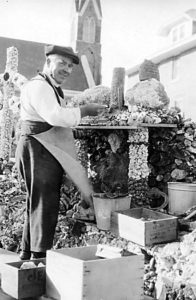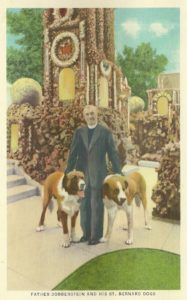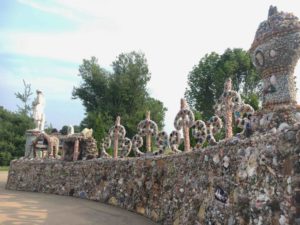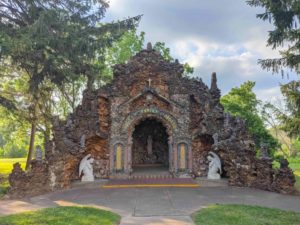Small Home Gazette, Spring 2022
Road Trip Into the Grotto Movement
Last summer, friends and I took a road trip planned around visits to roadside attractions. The most fabulous attraction of our trip was not on our agenda. Driving U.S. 61 through Dickeyville, Wisconsin, I did a doubletake and hit the brakes. We had just discovered the jaw droppingly delightful Holy Ghost Park and Grotto.

From an article about the Dickeyville grotto from the September 7, 1930, edition of the Wisconsin State Journal: “The grotto is the mecca of thousands of tourists, who motor to the spot to see and admire the structure. Every day, but especially on Sunday, the road past the grotto is lined with cars. The fame of the shrine had spread so widely that on one Sunday alone 50,000 tourists registered in the records of visitors at the grotto. Another Sunday recorded visitors from 32 states.”
Grottoes can be designed for worship or as part of landscaping. They are typically artificial caves, often surrounded by large gardens with water fountains and water features. Religious grottoes often have a main “cave” honoring the Virgin Mary that may be surrounded by additional shrines with statues of saints.
The Dickeyville Grotto seemed like crop art made into a walkable hardscape park with a mashup of a flamboyant, chaotic geology display. Instead of seeds glued to canvas, concrete structures—buildings, alcoves, and arches—are encrusted with a wild array of mixed media. Materials such as colored glass, pottery fragments and seashells are intermixed with quantities of geodes and gems, stalagmites and stalactites, and ores.
Environmental Folk Art in the Bungalow Era
The Dickeyville Grotto was one of many Midwest grottoes built in the 1920s and ‘30s. It was part of a regional trend of creating concrete sculpture gardens and other roadside attractions, fueled by a budding federal highway system and the increasing availability of automobiles, leisure time and quick-setting concrete.
Concrete had become cheap and available on a non-industrial scale. It was easy to work with and embellish, without formal workman training or arts education. Self-taught artists often spent years, even decades, obsessively constructing concrete homages to God and country, or documenting their lives and the world around them.
Environmental folk artists did not work alone in their massive undertakings. Devoted parishioners, family members, and friends contributed years of labor and often finished or expanded the sculpture gardens after the inspiring artist died.
Today, these concrete grottoes and sculpture gardens are considered environmental folk art, also called vernacular or outsider art, because the artists were self-taught. The Kohler Foundation, based in Wisconsin, works to preserve these art environments as cultural heritage sites.
Midwest Grotto Movement
The Midwest has the largest concentration of Catholic grottoes in the world, with three especially grand grottoes. Most of these grottoes were the visions of German-Catholic immigrants who influenced each another with their creations.
Grotto of the Redemption
The grotto movement started in the Midwest when Father Paul Matthias Dobberstein contracted pneumonia as a young seminarian. He prayed to the Virgin Mary and vowed to build a shrine to her if he survived. A small stone grotto in honor of Our Lady of Lourdes, at St. Francis Seminary in Wisconsin, is attributed to Dobberstein. That was merely a practice tribute, as the priest went on the build the Grotto of the Redemption, the grandest of the Midwest grottoes.
Constructed between 1912 and 1954, Grotto of the Redemption consumes an entire city block, with nine contiguous grottoes. Father Dobberstein, educated in geology, stockpiled massive amounts of fieldstone, rocks, and boulders for more than a decade, before beginning work on the grotto. Grotto of the Redemption is said to be the largest collection of semiprecious stones, minerals, and petrified materials in the world, and it is valued at $4.3 million.
Dobberstein was also commissioned to construct six smaller grottoes for Catholic churches and convents in Iowa, Wisconsin and Illinois, as well as three civic commissions.
Dickeyville Grotto
The Dickeyville Grotto is the inspiration of Father Mathias Wernerus, a German-born Catholic priest. He began by constructing a Soldiers’ Memorial in 1920 to honor three men from the parish who lost their lives in WWI. Between 1924 and 1930, his work expanded into a vision of a grotto “dedicated to the unity of two great American ideals—love of God and love of country.”
Wernerus built the grotto entirely of donated rocks and geodes. He collected materials and asked his congregation to collect as well. His call for donations attracted gifts of precious shells, crystals, colored pebbles, onyx, coral, and petrified moss from each of the U.S. states, as well as Europe, Asia and South America. The Ford Motor Company in Detroit sent a collection of balls from Model T stick shifts, which appear prominently in the Sacred Heart shrine. Six or seven truckloads carrying 30 tons of rock and minerals each came from quarries in the Dakotas, Iowa and Wisconsin.
Rudolph Grotto
While studying to become a priest in Austria, Father Philip J. Wagner suffered from exhaustion. He traveled to the Lourdes Grotto in France. Like Dobberstein, he prayed to the Virgin Mary and vowed to build a shrine to her if he recovered.
In 1919, nine years before building his first grotto in Rudolph, Wisconsin, Father Wagner began to transform a potato field into a labyrinth of garden spaces, with dozens of varieties of trees and shrubs. Unlike the more exotically embellished grottoes, the Rudolph Grotto is constructed primarily of native rock and is adorned with mature trees and extensive floral gardens.
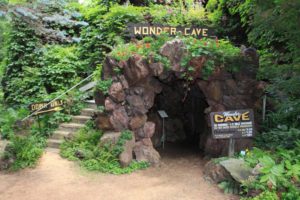 After building a series of shrines, he spent the next 20 years constructing the Wonder Cave. This winding, enclosed, above-ground pathway is one-fifth of a mile long, with dozens of religious statues and plaques.
After building a series of shrines, he spent the next 20 years constructing the Wonder Cave. This winding, enclosed, above-ground pathway is one-fifth of a mile long, with dozens of religious statues and plaques.
After experiencing Dickeyville, the Grotto of the Redemption and the Rudolph Grotto are on my travel bucket list. I encourage you, too, to lose yourself in one of these landscapes of obsessive passion.
Plan Your Trip
Grand Scale Catholic Grottoes
- Dickeyville Grotto, Holy Ghost Church, Dickeyville, WI
dickeyvillegrotto.com - Grotto of the Redemption, Saints Peter and Paul Church, West Bend, IA
westbendgrotto.com - Rudolph Grotto Gardens and Wonder Cave, St. Phillip Parish, Rudolph, WI
rudolphgrotto.org
Smaller Catholic Grottoes
- Holy Family Grotto, Dubuque, IA
roadsideamerica.com/tip/71441 - Holy Family Grotto, Villa St. Joseph, St. Joseph Ridge, WI
mnmuseumofthems.org/Grotto/
VillaStJoseph.html - Mother of Sorrows Grotto, Mount Mercy University, Cedar Rapids, IA
mtmercy.edu/about/mission-identity/grotto - Our Lady of Grace Grotto, West Burlington, IA
dmcountycatholic.org/home/history and
catholicmessenger.net/2017/07/three-grottoes-in-iowa-are-spiritual-gems/
Europe
- Our Lady of Lourdes, France
lourdes-france.org/en/passing-through-the-grotto/ - Shell Grotto of Margate, England
historicmysteries.com/shell-grotto-of-margate/









